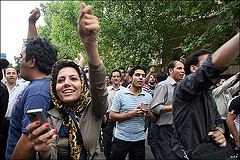 First off, do not get me wrong here, I applaud social networking and what it can deliver and fully support integration into existing processes for Public Affairs/Public Relations/Public Diplomacy and this group is a step in the right direction. However, one thing that has always bugged me is how we go into the overseas environment and attempt to take Western processes into other cultures. Having spent several consecutive years living in Europe and deploying all over, I could see firsthand how we fail in getting the message out to a foreign audience. The state department has taken a delegation of “social networking” types into Iraq to “provide conceptual input as well as ideas on how new technologies can be used to build local capacity, foster greater transparency and accountability, build upon anti-corruption efforts, promote critical thinking in the classroom, scale-up civil society, and further empower local entities and individuals by providing the tools for network building.” All that is lofty press release jargon for something, but i’m not sure what. One of the executives is @jack, co-founder of the social networking site Twitter.com. He has Tweeted his experiences, to include imagery from his trip, and shared it with his followers — pretty cool.
First off, do not get me wrong here, I applaud social networking and what it can deliver and fully support integration into existing processes for Public Affairs/Public Relations/Public Diplomacy and this group is a step in the right direction. However, one thing that has always bugged me is how we go into the overseas environment and attempt to take Western processes into other cultures. Having spent several consecutive years living in Europe and deploying all over, I could see firsthand how we fail in getting the message out to a foreign audience. The state department has taken a delegation of “social networking” types into Iraq to “provide conceptual input as well as ideas on how new technologies can be used to build local capacity, foster greater transparency and accountability, build upon anti-corruption efforts, promote critical thinking in the classroom, scale-up civil society, and further empower local entities and individuals by providing the tools for network building.” All that is lofty press release jargon for something, but i’m not sure what. One of the executives is @jack, co-founder of the social networking site Twitter.com. He has Tweeted his experiences, to include imagery from his trip, and shared it with his followers — pretty cool.
In a previous post I discussed how Social Media is a buzz word. It is not a panacea to fix everything. Bringing social networking to the Iraqis is not going to save them from anything. In fact, one has to wonder how they can access social networking or if the infrastructure was in place to do it yet (for example, no 100% reliable electrical grid yet). I am sure some are, but is it the academics, politicos and elites only? How does the everyday citizen get his information? Whatever the case may be, I do think there is a place for social networking in the new Iraq. The key is for the effort to be developed by the Iraqi culture for its use — not modeled after American communication trends and theories. During one of my graduate classes at the University of Oklahoma, Intercultural Communication, one of the points Dr. Clemencia Rodriguez kept discussing was how when we developed communication programs for foreign audiences we must do so within the context of the cultures, by using the culture’s idioms and customs of communicating, not ours. Dr. Rodriguez places a high importance on the need to understand Intercultural Communication and rightly so. Her thought is tied to the concept of the global village (which I believe social networking has a key stake in), she says;
“Never before did our world resemble so closely what Marshall McLuhan called ‘the global village.’ The economic functions around transnational corporations and international markets; peoples from different parts of the world migrate — for different reasons — to other parts of the world; the work-force has become diverse in many different ways: people of different ages, genders, ethnicity, race, religions, languages, have to live and work together. All this means that never before has good intercultural communication been so valuable.”
We absolutely must address how we communicate with our audiences (stakeholders) both in the home station and deployed environment. More often than not, Dr. Rodriguez’s point is spot on, the communities PA practitioners target are no longer of one nationality or another, they are a blend of nationalities — whether overseas or in the United States. Our communication practices, using traditional methods as well as social networking will still deliver no effect if the message and meaning are not framed within these cultural contexts. In other words, not thinking what would be good for us in terms of communicating an idea, but asking the people of that culture how they would do it and what is good for them. Would Iraqis even Twitter or FaceBook? Probably. Shortly after the fall of the Hussein government, the proliferation of satellite dishes took off, dubbed in some media circles the national flower of Iraq. People wanted access to information: information that was previously controlled. Social networking does offer Iraqis this access to unrestricted information.
Social networking does offer access, but it does not cure the delivery of a message no one wants to hear (by this I mean a poorly written message); or the delivery of a message in the wrong cultural context. As we move more into Phase 0 type of operations, Public Affairs must shift from reactive to a more proactive and culturally-centric form of outreach in the deployed environment. I happen to agree with Matt Armstrong, from MoutainRunner.us, that PA officers and SNCOs should probably be trained more like Public Diplomacy officers rather than Journalists.
Along with the technology group that went to Baghdad there should have been experts in Iraqi interpersonal communication. Integrate the way Iraqis communicate with each other and the access social networking can provide, and I see a winning combination. Do only one or the other, or worse – design it from an American viewpoint – and you can only have a failure to communicate.



 First off, do not get me wrong here, I applaud social networking and what it can deliver and fully support integration into existing processes for Public Affairs/Public Relations/Public Diplomacy and this group is a step in the right direction. However, one thing that has always bugged me is how we go into the overseas environment and attempt to take Western processes into other cultures. Having spent several consecutive years living in Europe and deploying all over, I could see firsthand how we fail in getting the message out to a foreign audience. The state department has taken a
First off, do not get me wrong here, I applaud social networking and what it can deliver and fully support integration into existing processes for Public Affairs/Public Relations/Public Diplomacy and this group is a step in the right direction. However, one thing that has always bugged me is how we go into the overseas environment and attempt to take Western processes into other cultures. Having spent several consecutive years living in Europe and deploying all over, I could see firsthand how we fail in getting the message out to a foreign audience. The state department has taken a  The Air Force has released its Social Media handbook and video on how the Air Force is encouraging its members to use Social Media. The handbook made its debut at the 2009 AF Public Affairs Leadership Development Seminar in Herndon, VA. It was quite the hit, and the handbook has started to make its way around other government agencies and large companies as they search for a way to jump start their SM ventures. Clearly the AF is ahead of most on the use of Social Media. Thanks largely in part to Maj Gen
The Air Force has released its Social Media handbook and video on how the Air Force is encouraging its members to use Social Media. The handbook made its debut at the 2009 AF Public Affairs Leadership Development Seminar in Herndon, VA. It was quite the hit, and the handbook has started to make its way around other government agencies and large companies as they search for a way to jump start their SM ventures. Clearly the AF is ahead of most on the use of Social Media. Thanks largely in part to Maj Gen